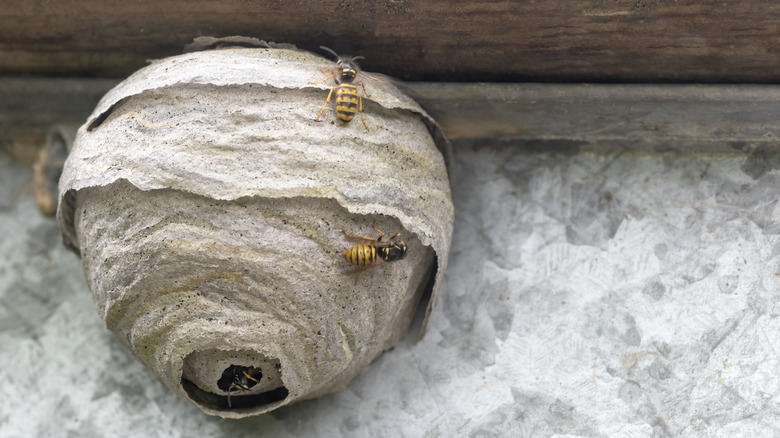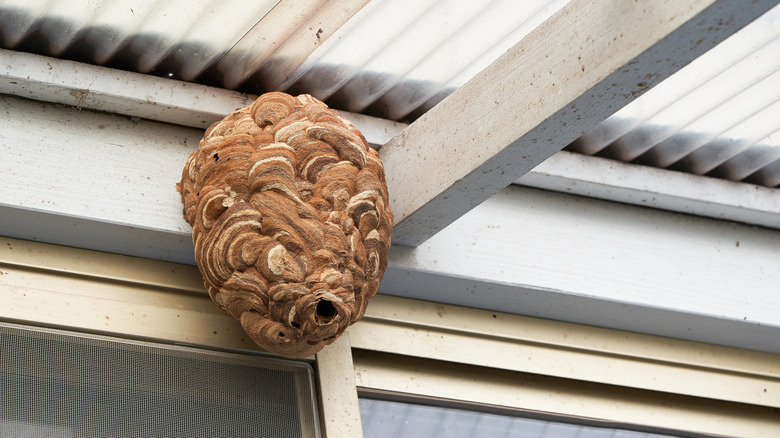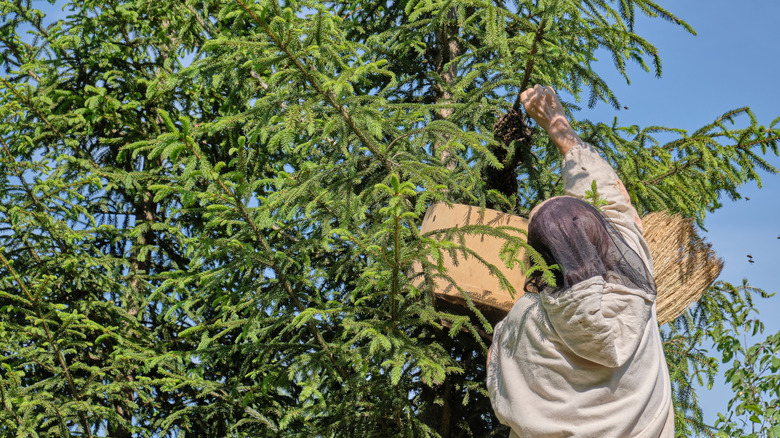Do Wasps Reuse The Same Nest? Tips You Should Know
For some people, the scariest part of owning a home isn't dealing with hefty renovation costs or the hassle of updating outdated features — it's the sudden appearance of a wasp's nest. Whether it's hanging from the eaves of a shed or wedged into the corner of a porch ceiling, these papery nests are enough to make you hesitate before stepping outside. While your first instinct might be to remove the nest, it's important to go about the process safely to minimize the risk of injury. If you notice an old nest, you might be wondering whether or not wasps reuse their previous spots. Luckily, most wasps will not reuse a nest after it has been abandoned, and it's safe to remove it once the threat is completely gone.
Even though wasps don't return to old nests, spotting an empty nest doesn't always mean your home is completely safe from wasps. The insects often build nests in areas they deem safe, meaning they may return to your yard year after year if your home provides everything they need to survive. Watch for starter nests, typically no larger than a golf ball, that may emerge in the spring, and knock them down before they have time to grow. Sealing small cracks in your home, clearing excess debris, and even using essential oils like peppermint oil can be effective deterrents. With a few helpful tips, you can get ahead of potential wasp problems before they occur.
How to identify old nests vs new ones
There are a few ways to keep wasps out of your garden all summer long, but removing nests is a good start. Being able to identify a new versus old nest helps you determine how to proceed and may save you from a future hospital visit. Is the nest from a prior season or an active one buzzing with workers? The easiest way to determine the status of a nest is by its appearance. Old nests are typically dry, faded, or brittle-looking with a gray, papery texture. They may have holes or cracks in the surface of the nest from exposure to weather and a lack of upkeep. Most importantly, the nest will be completely quiet, lacking a distinctive buzzing that is present in active hives. If you don't see wasps actively moving in or out of the nest, especially on a warmer day, it's likely no longer in use.
Newer nests tend to appear more intact and are often shinier or smoother on the surface, especially if they're being built. Activity is the tell-tale sign of a newer nest, as wasps enter and exit the nest regularly. Some may be on the exterior of the nest or hanging around it. Wasps are typically active throughout the day, but they may slow down as the day progresses and the heat increases. You may not notice movement at night, even if the nest is active, so checking in the morning is ideal. Observe each nest from a safe distance to minimize the risk of getting stung while you check for potential movement, buzzing, or activity.
Safely removing an old wasp nest
Now that you've confirmed the presence of an infestation, you'll want to remove the wasp nest in the safest way possible, which depends on the level of activity within the nest. If it's an old, inactive nest, the process of removing it is fairly straightforward. Grab a pair of gloves, cover your skin, and dislodge it using a broom or scraper. Nests located in particularly high areas may require a ladder, but double check that it is inactive before attempting to climb to potentially dangerous heights. Gently place the removed nest in a sealed bag, and toss it in the trash.
The removal process is a different story if the nest is still active. Wasps are highly territorial insects, and they are quick to defend their home from potential threats. If you're dealing with a small infestation, you can try using a wasp removal spray that is designed to attack from a distance. Remove the nest at night when the wasps are less active and more likely to be inside. Avoid the area for a full day to prevent exposure to the chemicals and any angry insects that may be lingering.
When dealing with larger or hard-to-reach nests, calling a professional may be the smartest move. They have access to specialized equipment that allows them to remove the nest safely and check for signs of potential return. No one wants to deal with the return of a swarm, but with these essential tips, you're better prepared for dealing with future infestations that may occur.


